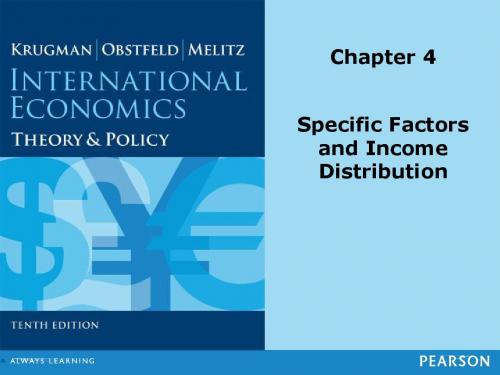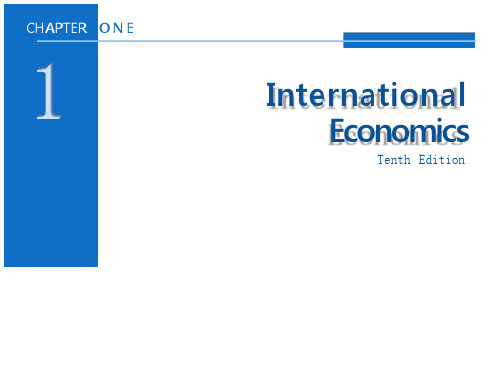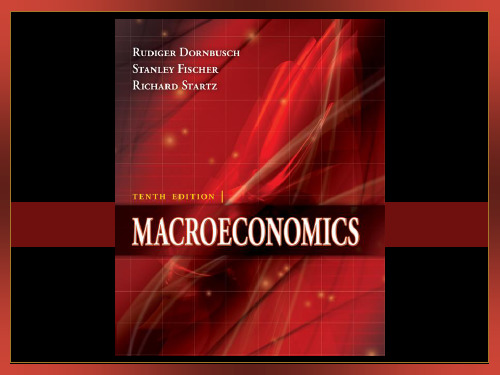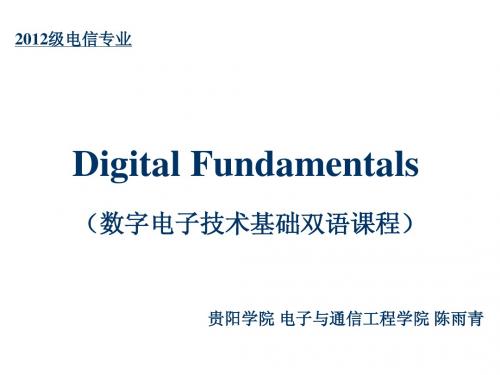digital fundamentals 英文版 第十版 课件 第四章
《电子技术数字基础-Digital-Fundamentals》双语课件

Distributive Law (分配律) A(B+C)=AB+AC
6
4-2-2 Rules of Boolean Algebra (基本公式)
1. A+0= A A variable ORed with 0 is always equal to the variable.
2
4-1 Boolean Operations and Expressions
Boolean algebra (布尔代数) is the mathematics of digital systems.
Sum term (和的形式): is a sum of literals (文字) ( a variable or the complement of a variable), produced by an OR gate.
X A B, X A B, X A B C D
A sum term is equal to 1 when one or more of the literals in the term are 1.
A sum term is equal to 0 only if each of the literals is 0.
19
4-4 Boolean Analysis of Logic Circuits
Ex. X=A(B+CD)
20
4-4 Boolean Analysis of Logic Circuits 4-7 Boolean Expressions and Truth Table
DigitalFundamentals第十版课程设计

Digital Fundamentals 第十版课程设计简介Digital Fundamentals 是一本关于数字电子学的教材,作者为Thomas L. Floyd。
本书主要介绍了数字电路设计、数字信号处理等方面的知识。
第十版主要更新了与IoT相关的内容,包括Wi-Fi、蓝牙、LoRa、ZigBee等。
本课程设计主要是基于该教材,结合实际场景,制定出的一套全面而系统的教学方案。
教学目标知识目标1.掌握数字电路的基本概念、设计原理和实现方法;2.熟悉数字电路各种不同的技术和器件;3.熟悉数字信号处理的基本概念、设计原理和实现方法;4.熟悉数字信号处理的各种不同的技术和器件;5.掌握数字电路和数字信号处理在实际应用中的设计方法和技巧;6.熟悉数字电路和数字信号处理领域内的最新发展趋势。
技能目标1.能够进行数字电路和数字信号处理的基础演算;2.能够进行数字电路和数字信号处理的模拟仿真和实际测试;3.能够进行数字电路和数字信号处理的实际应用设计;4.能够进行数字电路和数字信号处理领域内的最新发展趋势研究和探索。
情感目标1.培养学生对数字电路和数字信号处理领域的浓厚兴趣;2.培养学生进行数字电路和数字信号处理实际应用设计的能力;3.培养学生进行数字电路和数字信号处理领域内的最新发展趋势研究和探索的意识。
教学内容本课程主要分为两个部分:数字电路和数字信号处理。
具体内容如下:数字电路1.数字电路基础概念1.数字电路的基本组成和特点;2.二进制算术运算;3.真值表和卡诺图法。
2.组合逻辑电路设计1.组合逻辑电路的基本概念;2.组合逻辑电路的转换和化简方法;3.组合逻辑电路的编码器、译码器和多路选择器;4.组合逻辑电路的加法器和减法器;5.组合逻辑电路的比较器和数字比例器。
3.时序逻辑电路设计1.时序逻辑电路的基本概念;2.时序逻辑电路的分析和设计方法;3.时序逻辑电路的触发器和寄存器;4.时序逻辑电路的计数器和定时器。
宏观经济学多恩布什第十版ppt课件

是从最终使用的角度反 映国内生产总值最终使 用去向的一种方法。最 终使用包括货物和服务 的最终消费、资本形成 总额和净出口三部分。
价格指数与通货膨胀率计算
价格指数
是反映不同时期一般价格水平的变化方向和变化程度的相对数。常见的价格指 数有消费物价指数(CPI)、批发物价指数(WPI)和GDP折算指数。
宏观经济学多课恩件布什第十版ppt
2024/1/28
1
contents
目录
2024/1/28
• 宏观经济学导论 • 国民收入核算与衡量 • 失业、通货膨胀与货币政策 • 长期经济增长与经济发展 • 总供给与总需求模型及其应用 • 国际经济关系与全球化进程中的挑战
2
01
宏观经济学导论
2024/1/28
技术进步是提高生产率和经济 增长的重要途径。通过加强科 技创新、促进科技成果转化、 培养高素质人才等方式,可以 推动技术进步和经济增长。
制度创新是经济增长的重要保 障。通过深化经济体制改革、 完善市场体系、加强法治建设 等方式,可以推动制度创新和 经济增长。
26
经济发展战略和政策选择
2024/1/28
长期经济增长与经济发展
2024/1/28
25
长期经济增长源泉和影响因素剖析
劳动力
资本积累
技术进步
制度创新
劳动力的数量和质量是影响长 期经济增长的重要因素之一。 随着人口红利的逐渐消失,提 高劳动力素质、促进劳动力流 动和优化配置将成为未来经济 增长的关键。
2024/1/28
资本积累是经济增长的重要源 泉。通过增加投资、提高投资 效率、促进资本市场发展等方 式,可以推动资本积累和经济 增长。
17
通货膨胀定义、类型及成因探讨
克鲁格曼国际经济学课件英文官方第10版1第四章

4-10
Production Possibilities (cont.)
• For the economy as a whole, the total labor employed in cloth and food must equal the total labor supply: LC + LF = L (4-3) • Use these equations to derive the production possibilities frontier of the economy.
4-2
Introduction
• If trade is so good for the economy, why is there such opposition? • Two main reasons why international trade has strong effects on the distribution of income within a country:
• the slope becomes steeper as an economy produces more clon Possibilities (cont.)
• Opportunity cost of producing one more yard of cloth is MPLF/MPLC pounds of food.
– T is the supply of land – LF is the labor force employed in food
4-7
(4-2)
Production Possibilities
• How does the economy’s mix of output change as labor is shifted from one sector to the other? • When labor moves from food to cloth, food production falls while output of cloth rises. • Figure 4-1 illustrates the production function for cloth.
北师大课标版高中英语必修4Unit 10 Lesson4共31张

to problems.
02
It mentions the a
as well as the
usage of the product.
At last, it tells you the p
and
how you can buy it.
03 04
→
Do you find housework tiring and boring? Are you worried
Adjectives
Adverbs&Noun
s
Phrases
gorgeous, compact( 袖珍的 ), remarkably 显著 empower( 使自主)
new, fashionable, stylish,
地
your learning; the
fantastic, cheap,
completely (完 latest edition; an
II. From the sentence level:
Read & analyze: What types of sentences are used in
advertisements?
Give some examples.
1. Q ______; 2. S ______ sentences; 3. I ______ sentences; 4. Sometimes, you may just use some w_____ or
attractive strong
attractive
useful
satisfied
Feline Floor Cleaners
perfect practical
国际经济学英文课件(萨尔瓦多第十版)

International Economic Theories and Policies ■ International Trade Theory 国际贸易理论
■ Analyzes the basis of and the gains from international trade.
FIGURE 1-3 Imports and Exports as a Percentage of U.S. GDP, 1965-2001.
Salvatore: International Economics, 10th Edition © 2010 John Wiley & Sons, Inc.
■ 1980 to present
■ Most pervasive and dramatic period of globalization 全球化最广泛和剧烈的阶段
■ Fueled by improvements in telecommunications and transportation 受益于电信和运输极大改善
imports and exports of goods and services to GDP 用一国商品和服务进出口总值比上GDP的比值来 粗略衡量
Salvatore: International Economics, 10th Edition © 2010 John Wiley & Sons, Inc.
Salvatore: International Economics, 10th Edition © 2010 John Wiley & Sons, Inc.
International Trade and the Nation’s Standard of Living
宏观经济学多恩布什第十版ppt课件

The Desired Capital Stock
To derive the rental cost of capital:
› firms finance the purchase of capital by borrowing over time, at an intetal Stock
Firms use capital, along with labor and other resources, to produce output The goal of a given firm is to maximize profits
Figure 14-1 illustrates the volatility of investment by comparing investment and GDP
[Insert Figure 14-1 here]
Introduction
The theory of investment is the theory of the demand for capital
When deciding the optimal level of capital, The mafrirgminasl pmroduucsttofbcaapiltaalniscthee intchreeasecinoonuttpruibt purotdioucnedtbhy austing
more ca1pmiotrae ul nmit oaf ckaepistaltion ptrhodeucirtiorne. venues against the cost of acquiring additional The rental c(usaerp) ciotsat olf capital is the cost of using 1 more unit of capital in production.
北师大版高中英语必修四 Unit 10 Lesson 4教学课件

Group 2
Name of the product
Remote headphone
Price of the product Advantages:
£80.45
can hear stereo/TV up to 60 metres away and through glass, wooden doors and walls. top quality sound. excellent value, no wires.
relaxing, exciting, tiring, boring
“-ed” adjectives: used to describe a person or animal that experiences an emotion 一般 表示人,“感到…的 ”
“-ing” adjectives: used to describe the things that cause an emotion 一般表示物,“令人 感觉…的” Seeing the delighting result, we are all delighted. The father was disappointed at the disappointing news that his son failed the exam.
plus prep.
1. 加,加上 Five plus two equals seven.
五加二等于七。 2. 外加;另有 The work of an engineer requires intelligence plus experience. We've got to fit five people plus all their luggage in the car.
尼克尔森《微观经济理论基本原理与扩展》第十版官方英文版教学PPT课件

• value meant “value in use” • price meant “value in exchange”
The Economic Theory of Value
• Labor theory of exchange value
Positive-Normative Distinction
• Positive economic theories seek to explain the economic phenomena that are observed
• Normative economic theories focus on what “should” be done
costs) – government regulators seek to maximize
public welfare
Optimization Assumptions
• Optimization assumptions generate precise, solvable models
• Optimization models appear to perform fairly well in explaining reality
Slides created by Linda Ghent
Eastern Illinois University
Chapter 1
Economic Models
Theoretical Models
• Economists use models to describe economic activities
DigitalFundamentals第十版课程设计

Digital Fundamentals 第十版课程设计一、课程总述《Digital Fundamentals》是一门介绍数字逻辑、数字系统设计和数字信号处理基础的课程。
本课程旨在使学生掌握数字系统和数字信号处理的理论基础,为下一步学习数字系统设计和数字信号处理打下基础。
本课程包括数字系统基本概念、数字逻辑门、布尔代数、组合逻辑、时序逻辑、以及数字信号处理基础等内容。
二、课程目标本课程的目标是:1.掌握数字逻辑和数字信号处理的基础知识;2.能够设计数字系统并进行仿真实现;3.能够应用数字信号处理技术解决实际问题;4.了解数字电路设计的前沿技术和发展趋势。
三、课程内容3.1 数字系统基本概念1.数字系统的定义和特点;2.数字系统的进位和补码;3.数字系统的算术运算和逻辑运算;4.数字系统的编码和译码。
3.2 数字逻辑门1.与门、或门和非门;2.与非门、或非门和异或门;3.多输入逻辑门;4.数字逻辑门的应用。
3.3 布尔代数1.布尔代数的基本概念和运算规律;2.布尔函数的最小化;3.卡诺图方法和四变量K-图;4.布尔代数的应用。
3.4 组合逻辑1.组合逻辑电路的设计原则;2.组合逻辑电路的基本模块;3.组合逻辑电路的应用;4.组合逻辑电路的多路选择器和多级逻辑电路。
3.5 时序逻辑1.时序逻辑电路的基本概念和设计方法;2.时序逻辑电路的时钟和时序分析;3.时序逻辑电路的同步和异步设计;4.时序逻辑电路的应用。
3.6 数字信号处理基础1.数字信号的采样、量化和编码;2.离散时间信号和离散时间系统;3.离散傅立叶变换和快速傅立叶变换;4.数字信号处理的应用。
四、教学方法和学习评价4.1 教学方法本课程的教学方法采用理论讲解与实践演练相结合的方式。
具体来说,通过手工设计数字逻辑电路,学生可以更好地理解数字系统和数字信号处理的基础知识,并能够灵活运用所学理论知识。
4.2 学习评价本课程的学习评价分为两部分:平时考核和期末考试。
高中英语北师大版模块4【教学课件】Unit 10 Lesson 4

falling leaves 正在下落的叶子
北京师范大学出版社 |必修四
当然也有意义上的区别,在一些特定的词语上,如 interesting和interested,exciting和excited这类词,-ed 表示个人的感情,-ing则表示物体的性质。
如: interesting game 好玩的游戏 excited boy 兴奋的男孩
北京师范大学出版社 |必修四
exciting (excited/ exciting) 6. There was a really _______ basketball game in the stadium. However, I was a bit disappointed ___________ (disappointing/ disappointed) that my team lost, though!
北京师范大学出版社 |必修四
Unit10 Lesson 4
Advertisements
北京师范大学出版社 |必修四
Lesson 4 Advertisements
Objectives
☆ To read a text and distinguish facts from
opinions
☆ To use -ed and -ing adjectives
fantastic, Remote exciting, Headphones new, excellent
北京师范大学出版社 |必修四
Product Special Jewellery for Your Ears
Opinions
attractive, useful
Facts
1. used in many different situations 2. a bargain at ₤19.50 1. made from good quality nylon 2. easy to wash 3. complete set for only ₤5.99
《电子技术数字基础 Digital Fundamentals》双语课件PPT-第03章 Logic Gates

29
3-5 The NOR Gate
The NOR gate produces a LOW output when any of the inputs is HIGH, and HIGH only when all of its input are LOW. For a 2-input NOR gate, the output X is LOW if either A or B is HIGH, and HIGH if both A and B are LOW.
4
1-3-1 NOT Logic Operation
Function (逻辑功能): changes one logic level to the opposite level. Changes a 1 to a 0 and a 0 to a 1. Logic symbol
•
E
•
A Y
5
1-3 Basic Logic Operations
X AB
NAND gates can be used in combination to perform the AND,OR and inverter operation.
28
3-5 The NOR Gate (或非门)
The term NOR is a contraction of NOT-OR and implies an OR function with a complemented (inverted) output.
XA
The complement variable can be read as “A bar” or “not A” (A反). If A=0, A=1
14
多恩布什宏观经济学第十版原版ppt

3.
•
Short Run Model: business cycle theories
•
[Insert Figure 1-4 here]
The AS curve is flat in the short run due to fixed/rigid prices, so changes in output are due to changes in AD
•
Changes in AD in the short run constitute phases of the business cycle
1-4
•
Very Long Run Growth
•
•
•
Figure 1-1a illustrates growth of income per person in the U.S. over last century growth of 2-3% per year Growth theory examines how the accumulation of inputs and improvements in technology lead to increased standards of living Rate of saving is a significant determinant of future well being and economic growth.
《电子技术数字基础_Digital_Fundamentals》双语课件01(陈雨青)

Digital and Analog Quantities
An analog quantity (模拟量)is one having continuous (连续的) values.
A digital quantity (数字量) is one having a
discrete (离散的 )(discontinuous) set of
0-2-3 Digital Waveforms (数字波形)
The pulse: rising (leading) edge (上升沿)and falling (trailing) edge (下降沿). Pulse width : (脉宽) the duration of the pulse. Period T (周期) : the fixed interval repeated by the periodic pulse . Frequency f: the reciprocal (倒数)of the period.
0-2-1 Binary Digits
The two-state number system is called binary(二进制), and its two digits are 0 and 1. Positive logic (common) (正逻辑) Logic 0 False Off Logic 1 True On
Course Introduction
This course will present a strong foundation in the core fundamentals of digital technology. It will provide basic concepts reinforced by a plentiful illustrations, examples, exercises and applications. Through this course, students will master the all important fundamental concepts before they get into more advanced course.
- 1、下载文档前请自行甄别文档内容的完整性,平台不提供额外的编辑、内容补充、找答案等附加服务。
- 2、"仅部分预览"的文档,不可在线预览部分如存在完整性等问题,可反馈申请退款(可完整预览的文档不适用该条件!)。
- 3、如文档侵犯您的权益,请联系客服反馈,我们会尽快为您处理(人工客服工作时间:9:00-18:30)。
Summary
Rules of Boolean Algebra
Rules of Boolean algebra can be illustrated with Venn diagrams. The variable A is shown as an area.
The rule A + AB = A can be illustrated easily with a diagram. Add an overlapping area to represent the variable B. The overlap region between A and B represents AB.
The overlapping area between B and C represents BC. ORing with A gives the same area as before.
A B A+B A+C C A B
=
BC C
(A + B)(A + C)
Floyd, Digital Fundamentals, 10th ed
Floyd, Digital Fundamentals, 10th ed © 2009 Pearson Education, Upper Saddle River, NJ 07458. All Rights Reserved
ห้องสมุดไป่ตู้
Summary
Three areas represent the variables A, B, and C. The area representing A + B is shown in yellow. The area representing A + C is shown in red. The overlap of red and yellow is shown in orange.
Summary
Commutative Laws
The commutative laws are applied to addition and multiplication. For addition, the commutative law states In terms of the result, the order in which variables are ORed makes no difference.
Digital Fundamentals
Tenth Edition
Floyd
Chapter 4
Floyd, Digital Fundamentals, 10th ed
©Upper 2008 Pearson Education © 2009 Pearson Education, Saddle River, NJ 07458. All Rights Reserved
Each literal must = 1; therefore A = 1, B = 0 and C = 0.
Floyd, Digital Fundamentals, 10th ed
© 2009 Pearson Education, Upper Saddle River, NJ 07458. All Rights Reserved
Summary
Rules of Boolean Algebra Illustrate the rule A + AB = A + B with a Venn diagram. This time, A is represented by the blue area and B again by the red circle. The intersection represents AB. Notice that A + AB = A + B
7. A . A = A 8. A . A = 0 = 9. A = A
10. A + AB = A 11. A + AB = A + B
6. A + A = 1
12. (A + B)(A + C) = A + BC
Floyd, Digital Fundamentals, 10th ed
© 2009 Pearson Education, Upper Saddle River, NJ 07458. All Rights Reserved
Summary
Boolean Addition
In Boolean algebra, a variable is a symbol used to represent an action, a condition, or data. A single variable can only have a value of 1 or 0.
AB + AC
© 2009 Pearson Education, Upper Saddle River, NJ 07458. All Rights Reserved
Summary
Rules of Boolean Algebra
1. A + 0 = A 2. A + 1 = 1
3. A . 0 = 0 4. A . 1 = 1 5. A + A = A
A+B=B+A For multiplication, the commutative law states In terms of the result, the order in which variables are ANDed makes no difference. AB = BA
Floyd, Digital Fundamentals, 10th ed © 2009 Pearson Education, Upper Saddle River, NJ 07458. All Rights Reserved
Summary
Boolean Multiplication
In Boolean algebra, multiplication is equivalent to the AND operation. The product of literals forms a product term. The product term will be 1 only if all of the literals are 1. What are the values of the A, B and C if the product term of A.B.C = 1?
A + (B +C) = (A + B) + C For multiplication, the associative law states When ANDing more than two variables, the result is the same regardless of the grouping of the variables. A(BC) = (AB)C
The complement represents the inverse of a variable and is indicated with an overbar. Thus, the complement of A is A. A literal is a variable or its complement. Addition is equivalent to the OR operation. The sum term is 1 if one or more if the literals are 1. The sum term is zero only if each literal is 0. Determine the values of A, B, and C that make the sum term of the expression A + B + C = 0?
A + BC
© 2009 Pearson Education, Upper Saddle River, NJ 07458. All Rights Reserved
Summary
DeMorgan’s Theorem
DeMorgan’s 1st Theorem The complement of a product of variables is equal to the sum of the complemented variables. AB = A + B Applying DeMorgan’s first theorem to gates:
AB + AC = A(B+ C) The distributive law can be illustrated with equivalent circuits:
B C A B+ C X A B A C AB X AC
A(B+ C)
Floyd, Digital Fundamentals, 10th ed
Summary
Associative Laws
The associative laws are also applied to addition and multiplication. For addition, the associative law states When ORing more than two variables, the result is the same regardless of the grouping of the variables.
Floyd, Digital Fundamentals, 10th ed © 2009 Pearson Education, Upper Saddle River, NJ 07458. All Rights Reserved
